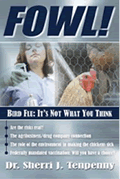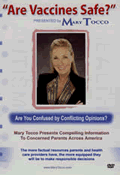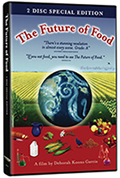Other
Tenpenny
Articles:
The Flu Season Campaign Begins
Vaccinations and The Right to Refuse
QUESTIONING VACCINES IS NOT "FUELED BY IGNORANCE"
Dr.
Sherri Tenpenny, DO
February 7, 2007
NewsWithViews.com
The vaccine debate is escalating. With 18 states currently considering laws to mandate the new HPV (cervical cancer) vaccine for school entry, the number of persons questioning the necessity of vaccination is at an all-time high. Those promoting vaccination seem to be pulling out all the stops to defend their positions.
On February 4, 2007, New York Times Online published a review of a new book, �VACCINE: The Controversial Story of Medicine�s Greatest Lifesaver, by Arthur Allen. Here is a portion of David Oshinsky�s review:
�Allen is sympathetic to parental fears regarding the dangers of various vaccines, though he remains skeptical that scientific studies of these dangers, no matter how rigorous, will open many minds. At this point, he writes, much of the �antivaccinist� leadership is composed of countercultural types who view life through the prism of conspiracy theory: the government lies, the drug companies are evil, the medical profession is corrupt; trust the Internet instead�.To a large extent, says Allen, this antivaccination impulse is fueled by an ignorance of the past. Vaccines have done their job so well that most parents today are blissfully unaware of the diseases their children are being inoculated against.
�The end result is a culture that has become increasingly risk-averse regarding vaccination because people have greater trouble grasping the reward. The problem appears to be growing. As more children go unvaccinated in the United States, there has been a rise in vaccine-preventable diseases. Meanwhile, fewer pharmaceutical companies are now producing vaccines, citing the high cost of testing, diminishing markets and a fear of litigation. For Allen, a reversal of these trends will require something long overdue: a frank national discussion about the risks and benefits of vaccination. His splendid book is a smart place to begin.�[1]
Allen�s book is one more in a recent series of books that give tribute to the "wonder of vaccines." The author and reviewer promote their views by disparaging intelligent adults and dedicated physicians who have researched the problems associated with vaccines and consider mass vaccination to be the casualty-causing loss-leader of the pharmaceutical industry. The drug companies count vaccine injuries as few, at least in part, because safety is concluded through the use of large epidemiological studies. The larger one makes the denominator, the easier it is to discount the size of the numerator. For example, 231 injured in a study that involved 679,900 persons makes the percentage of those injured appear unarguably small.[2]
But vaccine injuries are real despite claims that occurrences are rare. Fears of developing autism as a result of vaccination have been dismissed by mainstream medicine which prefers to attribute the increase incidence of autism, currently at 1 in 166 children, to a �better diagnosis.�[3] Thimerosal (mercury) in vaccines has received much attention in the association with autism. Undoubtedly, many children have been damaged by mercury in vaccines as the numbers of successful recoveries using chelation therapy attest. However, the rate of autism in California has continued to escalate despite the removal of mercury from most of the childhood vaccines.[4] The rest of the ingredients in the vaccines need to be investigated with the same intensity as mercury. The answers regarding these toxic substances are still forthcoming. [see Dr. Tenpenny's DVD: "Vaccines, the Risks, the Benefits, the Choices"]
Another avenue being heavily investigated is the search for genetic causes of autism spectrum disorders.[5] The identification of a corrupted gene will point an incriminating finger at defective parents as the �cause� of their child�s autism. A better use of scare research funds would be to investigate which bio-medical treatments are most effective for these ill children.
An exponential growth of childhood illnesses such as allergies/asthma, diabetes, ADD-ADHD and cancer has occurred over the last 10 years. Instead of suspecting the large numbers of vaccines now being injected into children by the time they enter kindergarten, drugs designed for adults have been given expanded approval for treatment of children.
Healthcare providers continue to view vaccination in the same way as described by Mr. Allan�s catchy book title: �Medicine�s greatest lifesaver.� This accolade is attributed to the reduction of childhood infectious diseases such as chickenpox, mumps and three-day measles. But can a negative truly be proven? The assumption of conventional medicine is that all children will be exposed and if exposed, all unvaccinated children will get sick. This is a faulty assumption. If a vaccinated child does not contract chickenpox, is it due to the protection of the vaccine? Or was it because the child was never exposed to the virus? What if an unvaccinated child is exposed but does not become sick? Isn�t that a testament to the health of the child�s immune system? Not every child in a classroom exposed to influenza comes down with the flu. Studies comparing the health of vaccinated vs. unvaccinated populations of children are very much needed.
A patient population from which this type of data could be accessed is the nearly 35,000 unvaccinated children cared for by Homefirst Health Services in metropolitan Chicago. The good health of these children can be assumed; there have been no reported cases of autism among this group.[6] Examining the health histories of these children would be a telling exercise. Discovering that large numbers of these unvaccinated children have not contracted �vaccine-preventable diseases� would deliver a serious blow to the concept that vaccination is needed to keep children healthy. An even more provocative study would be to examine how many drugs and other health problems exist among these 35,000 unvaccinated children.
If vaccines were safe, manufacturers would not require federal legislation to protect them from liability. If vaccines were effective, no one would question the value of their use. If vaccines were good for us, state mandates would not be necessary to force them upon children. A growing number of adults are investigating vaccines and discovering the truth about their contents. Vaccines are grown on monkey kidneys, chicken embryos and contain bovine (cow) serum. Vaccines contain particles of viruses, bits of bacteria and measurable amounts of aluminum, gelatin, polysorbate 80, MSG and other chemicals. A responsible adult who concludes that this combination of pathogens and chemicals can be harmful is not a �countercultural type who views life through a prism of conspiracy theory� as Mr. Allen contends. Understanding that autoimmune reactions can be the consequence of injecting animal cells and foreign chemicals into the body does not require a medical degree or PhD. Instead of calling them names, parents and physicians who question and challenge the dogma that has been spoon-fed to the general population for nearly two centuries should be commended.
In his book, Mr. Allen apparently calls for �a frank national discussion about the risks and benefits of vaccination.� I wholeheartedly agree. The real health risks of vaccination are well documented but rarely discussed. Beyond the impact of vaccines on health, the economic ramifications of vaccine injuries need to be exposed. Vaccine manufacturers and government officials attempt to justify the cost of vaccine programs by showing a correlation between dollars spent on immunization compared to healthcare dollars saved. For example, in 2005 it was reported that vaccinations saved more than $52 billion in total health care costs and 33,000 childrens� lives.[7] Because injuries are reported as rare, dollars spent to care for those who are injured are never published.
However, the medical expenses of a vaccine-injured person can be substantial and needs to be included in the economic profile. A distinct example comes from a study of VAERS reports between 1990 and 1995. A total of 697 patients were identified who experienced syncope (fainting spell) within 12 hours following vaccinations. Six patients had falls that resulted in a serious head injury, including skull fracture, cerebral bleeding and cerebral contusion. All six patients experienced the episode within 15 minutes of vaccination and were injured either in, or just outside, the office or clinic where the vaccination was given.
Three of these patients required surgery, and two were left with substantial residual deficit at six months to two years after follow-up.[8] Even though the number of patients in this report is small, these costs of their life-time care could be in the millions of dollars. Keep in mind this report encompasses only one injury example. Similar analyses for all other injuries should be undertaken. The expenditure of healthcare dollars to care for injured individuals could negate any meaningful �savings� touted by vaccine pundits.
|
Subscribe to the NewsWithViews Daily News Alerts! |
Since the government is the largest purchaser of vaccines, the cost to the American taxpayer for mandated state vaccination programs needs to be discussed. The Vaccines For Children Program (VFC) allows children and teens to get vaccines through Federally Qualified Health Centers or Rural Health Centers, purchased by government dollars, if their private health insurance does not cover the vaccine. In addition, mandated vaccines increase the cost of insurance for everyone, even those who do not have children or do not want to receive the vaccines. These costs, in addition to the requirement to vaccinate children in exchange for a public education, must be part of that �frank national discussion.�
Yes, Mr. Allen, a nationwide open discussion is long overdue.
Footnotes:
1.
Oshinsky, David. "Preventive Medicine." A book review of "VACCINE:
The Controversial Story of Medicine's Greatest Lifesave" published
on New York Times Online. February 4, 2007.
2.
Barlow, WE. et al. "The risk of seizures after receipt of whole-cell
pertussis or measles, mumps, and rubella vaccine. N Engl J Med. 2001
Aug 30;345(9):656-61. PMID: 11547719
3.
"A
better Diagnosis: What Newsweek Missed," by Dan Olmsted. January
20, 2006.
4.
M.I.N.D.
Institute Study Confirms Autism Increase.
5.
"Genetic cause of
autism." January 18, 2006.
6,
"The
Age of Autism: A pretty big secret," by Dan Olmsted. Dec. 7, 2005.
7,
Ensuring
a Stable Vaccine Supply. May 18, 2005.
8,
Braun MM, et al. Syncope after immunization. Arch Pediatr Adolesc
Med 1997;151:255-9.
�
2007 Sherri Tenpenny - All Rights Reserved
Dr. Sherri Tenpenny is respected as one of the country's most knowledgeable and outspoken physicians regarding the impact of vaccines on health. Through her education company, New Medical Awareness, LLC, she spreads her vision of retaining freedom of choice in healthcare, including the freedom to refuse vaccination. A portion of this article is an excerpt from her new book, FOWL! Bird Flu: It's Not What You Think, released in April, 2006. For daily updates on the bird flu, including the real reasons behind the hype, and a bi-weekly e-Newsletter with Dr. Tenpenny's commentary go to www.BirdFluHype.com
Dr. Tenpenny is a regular columnist for www.NewsWithViews.com. Her 3-hour vaccine DVD, Vaccines: The Risk, The Benefits and The Choices and her new book FOWL! are available through this site; other tapes and materials are available www.DrTenpenny.com
Website: www.DrTenpenny.com
Website: www.BirdFluHype.com
E-Mail: nmaseminars@aol.com
But vaccine injuries are real despite claims that occurrences are rare. Fears of developing autism as a result of vaccination have been dismissed by mainstream medicine which prefers to attribute the increase incidence of autism, currently at 1 in 166 children...














